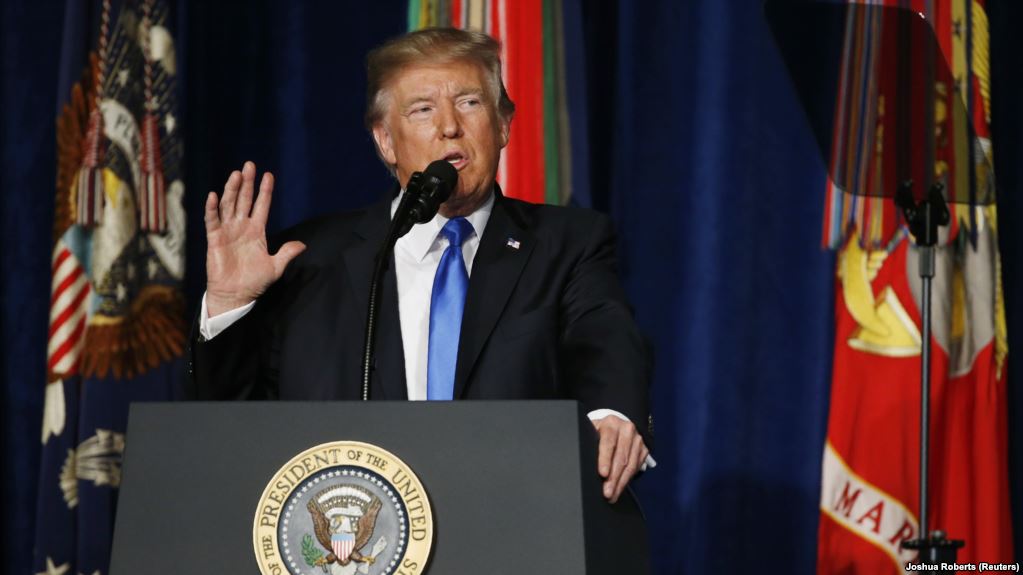
U.S. President Donald Trump announces his strategy for the war in Afghanistan during a speech from Fort Myer, Virginia, on August 21.(Reuters)
On August 21, US President Donald Trump unveiled his new Afghanistan strategy. Since the US-led coalition launched strikes against Al Qaeda and Taliban in Afghanistan in 2001, the 16-year conflict has imposed high costs on America: over 2,300 deaths, more than 10,000 injured, and over $840 billion spent. Afghanistan has become a quagmire for the US. Many observers are looking to see how well Trump will play his limited diplomatic and military cards and whether he can break the ancient curse of Afghanistan as the “graveyard of empires”. Although many commentators criticized the strategy as “putting old wine in a new bottle,” I think it charts a new course for the US to succeed in Afghanistan, and contains quite a few new elements. Because of this, Trump’s new strategy deserves a round of applause.
First, counterterrorism and security in Afghanistan is prioritized. Some commentators mocked Trump for changing his campaign position from pulling American troops out of Afghanistan to sending in 4,000 more. But we must allow for changes in attitude and position in line with changing circumstances. The deteriorating security situation and rampant terrorist activity in Afghanistan naturally calls for troop reinforcements rather than leaving a vacuum for terrorist groups to fill. According to statistics, there are around twenty active terrorist groups, and in the first half of this year alone, 1,662 civilians were killed and 3,581 injured in violence in Afghanistan, almost equaling the number of casualties in the whole year of 2016. Even though an additional 4,000 troops cannot fundamentally reverse the security situation, let alone root out terrorism (an ambitious objective not even achieved by the 100,000 more troops sent there by Barack Obama), troop reinforcement is a clear signal that the US is returning and assisting in maintaining security, which should be welcomed by Afghanistan and the rest of the international community. As a potential geographical pivot linking South Asia, Central Asia, East Asia, and Middle East, Afghanistan is critical to China’s Belt and Road initiative and the security of its western provinces. As such, China supports its neighbor in strengthening security and counterterrorism efforts. It also hopes to see American policies conducive to the security, stability, and development of Afghanistan and the region at large.
Second, the president accepted and called for ultimate resolution of the Afghan question through political dialogue and by relying on the Afghans. The troop increase is aimed at “attacking our enemies, obliterating ISIS, crushing al-Qaeda, preventing the Taliban from taking over Afghanistan, and stopping mass terror attacks.” But Trump did not set the eradication of the Taliban as a target. Rather, he clearly hopes to force the Taliban to the negotiation table by containing and squeezing areas under their control, now about half of all Afghan territory, so as to find an ultimate political solution. Trump, with his business background and pragmatic rather than ideological policy orientation, has embraced the principle of having Afghanistan ruled by the Afghans. According to him, “Afghans will secure and build their own nation, and define their own future. We want them to succeed. But we will no longer use American military might to construct democracies in faraway lands, or try to rebuild other countries in our own image…We are not asking others to change their way of life, but to pursue common goals.” A negotiated political solution and an Afghanistan ruled by Afghans are actually the principles the Chinese government has been advocating for in the peace process in Afghanistan. Acceptance of this principle should be applauded and will lay a solid foundation for close China-US cooperation in the political resolution process.
The Chinese government has always held the view that political dialogue is the only way out and that the international community should support a reconciliation process led and owned by Afghans and should help the Afghan people explore a path to development that is suited to their national conditions. When Chinese Foreign Minister Wang Yi met the American representative at the conference of the Istanbul Process on Afghanistan in Islamabad in 2015, he described China-US cooperation on Afghanistan as being part and parcel of the two countries’ global strategic cooperation and serving shared strategic interests. He expressed China’s willingness to strengthen communication and cooperation with the US, participate in peaceful reconstruction and the development of Afghanistan, support reactivation of the reconciliation process at an early date, encourage Afghanistan and Pakistan to improve bilateral relations, and assist Afghanistan in its effort towards peace, stability and prosperity. President Trump’s new strategy certainly contains other elements that are not discussed in this article. But these two strategic ideas are already conductive to stability in Afghanistan and to China-US cooperation on the Afghan question.


